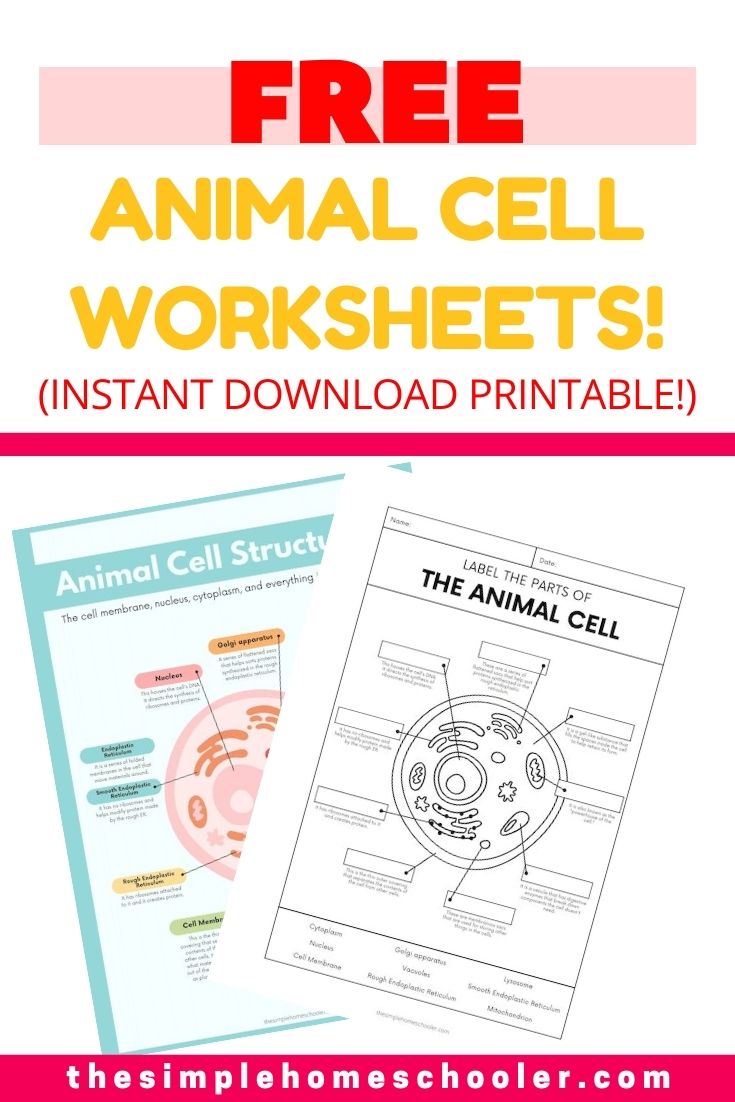
On the hunt for a plant cell worksheet to add to your science curriculum?
Maybe need a quick biology review to tuck into your science notebook?
Or an engaging science worksheet to give your students an introduction to plant cells?
I’ve got you covered!
Below you will find multiple free plant cell worksheets that include blank plant cell diagrams, word bank, descriptions of the cell organelles, and an answer key!
They can easily be used for the high school biology student or adapted as an introduction to cells for a younger student.
The first two blank worksheets have different difficult levels. The first one
****Scroll to the bottom of the page for your instant downloadable printable plant cell worksheets. Keep reading for some tips on how to use the worksheets and teach the content so it’s not dry and boring.

Plant cells are fascinating!
They are the building blocks of all living things in the plant world.
Each plant cell contains cellular organelles (like organs in our bodies) that have unique characteristics and distinct jobs that make the plant cell function correctly.
If you are going to teach the content, you might appreciate a simple breakdown of how each of the parts of a cell work. These descriptions are also included on one of the plant cell worksheets to help prompt the student.
Amyloplast: It serves as starch storage for plants.
Cell Membrane: Found inside the cell wall, it controls what materials go in and out of the cell.
Cell Wall: It is the cell’s outer cover. It protects and gives shape to the cell.
Central Vacuole: It stores waste, water, and nutrients. Most plants only have one vacuole.
Chloroplast: Through photosynthesis, this organelle makes sugar for the cell.
Cytoplasm: It is a thick liquid that fills spaces in the cell to help retain its form.
Druse Crystal: It stores excess calcium, called calcium oxalate, in plants. High amounts of this calcium makes a plant poisonous to humans.
Golgi apparatus: It is a series of flattened sacs that help sort proteins synthesized in the rough endoplasmic reticulum.
Mitochondria: It breaks down sugar (from the chloroplast) into energy that the cell can use. It is also called the “powerhouse” of the cell.
Nucleolus: It is the “brain” of the nucleus. It helps in the synthesis and production of ribosomes.
Nucleus: It gives instructions for different activities in the cell.
Ribosomes: It is where protein synthesis takes place.
Rough Endoplasmic Reticulum: This ER helps in the production and quality control of proteins. It also has millions of ribosomes.
Smooth Endoplasmic Reticulum: This ER helps in the production and synthesis of lipids. Unlike rough ER, it does NOT have ribosomes.

Students thrive and learn so much through discussion! Consider adding these questions into your lesson plan to engage your students and deepen their understanding.
Plant cells and animal cells do have a similar structure, but there are some huge differences.
Plant cells have a cell wall to give the plant structure. Animal cells don’t need a cell wall because they have endo or exoskeletons for structure.
Plant cells have chloroplast to aid in making food for the plant through the process of photosynthesis. Animal cells do not have chloroplast because they cannot make their own food.
Both animal and plant cells have a cell membrane, nucleus, mitochondria, Golgi apparatus, and endoplasmic reticulum among other things.
Plant cells are eukaryotic because they have a nucleus.
This is a little bit of a trick question. Each of the parts of a plant cell serves a crucial purpose. Even if they don’t seem like a big deal, if one organelle broke down, it would cause the cell to break down.

All the organelles of the plant cell can be overwhelming to learn all at once – even for older students.
For example, the central vacuole is like the closet of the plant cell. The cell membrane is like a very serious border police agent – they decide who can come in and who can leave the cell.
Work with your student to understand the parts of a cell this way and they will remember it much better.
Drawing is an excellent (and fun!) way to retain information!
Cut out the word bank and allow your student to practice matching them to the correct part of the cell. Much more hands-on than just copying with a pencil. Use the answer key for quick self-grading.
Some kids learn much better through media than from lectures. Consider opening your lesson with this informative and interesting cell video.

I hope these simple worksheets will be the perfect addition to your curriculum and lessons!
Teaching science with kids is so fun and rewarding. It really is one of my favorite subjects to teach.
If you haven’t already seen my animal cells worksheets, be sure to click below and grab that free printable too!


Hello! My name is Lauren and welcome to my blog! I am the wife of an amazing husband and we have 3 sweet girls. I never, ever saw myself becoming a homeschooler, but our family has been so blessed by the choice to school at home. I am passionate about helping you get on your feet with your homeschool and encouraging you on your journey!